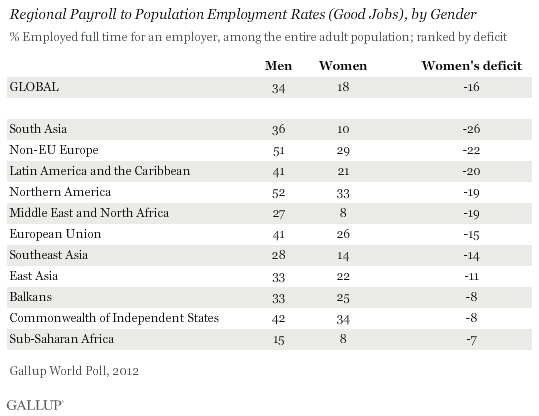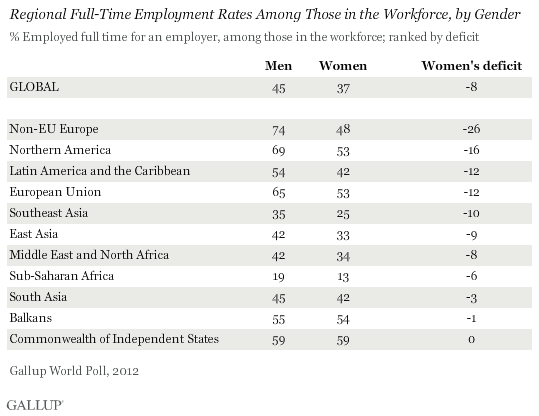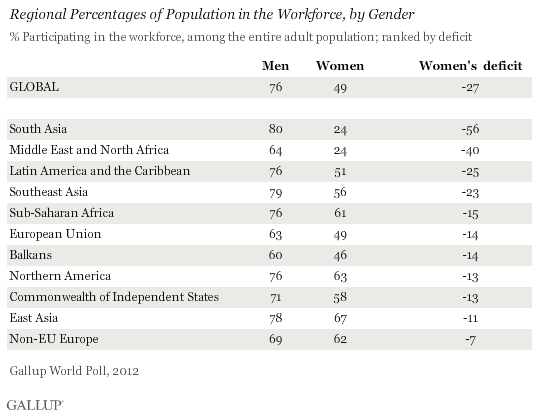WASHINGTON, D.C. -- In every region of the world, men surpass women when it comes to having a "good job" -- that is, full-time work for an employer, or what Gallup refers to as the Payroll to Population (P2P) employment rate. Worldwide, the P2P employment rate for men is 34%; it is 18% for women.

Across all regions, women's deficit in the good jobs market is biggest in South Asia, where their P2P rate lags men's by 26 percentage points. The good jobs gender gap that Gallup finds in South Asia aligns with recent data from the International Labour Organization (ILO). A 2012 ILO report on women's employment in the aftermath of the global economic crisis finds that South Asia's "already massive gender gap in the employment-to-population ratio" has increased. Further, the ILO says that the increase was accompanied by a "fall of 3 million female jobs, caused both by weakening female-dominated sectors like garments and by demographic change."
Women's deficit in good jobs is smallest, at seven points, in sub-Saharan Africa, but P2P rates are also among the lowest in the world for women and men in this region. P2P rates are also relatively low for both genders in the Middle East and North Africa (MENA) and in Southeast Asia, but the deficits for women are much larger in these regions. P2P rates are highest for men and women in Northern America and non-European Union parts of Europe (Iceland, Norway, Switzerland, and Northern Cyprus), but gender gaps are wide in these regions as well.
Globally, the P2P rate dropped to 26% in 2012, with similar declines observed among men and women.
Gender Gap Widest in the Workforce in Northern America, Parts of Europe
Gallup's P2P metric estimates the percentage of the adult population aged 15 and older who are employed full time for an employer for at least 30 hours per week. The P2P rate is the percentage of the entire adult population with good jobs, not just those who are in the workforce. In many countries, though, women are more likely to choose to not participate in the workforce for various cultural or political reasons. Thus, it is also important to look at full-time employment among just those in the workforce.
When it comes to just those who are in the workforce, women lag behind men most in full-time employment in parts of Europe and Northern America. Full-time employment is more equal among men and women in South Asia, the Balkans, and the Commonwealth of Independent States.

However, even though women's full-time employment trails men's most in Northern America and in non-EU European nations, those two regions are among the top three where women are most likely to be in the workforce. Women are least likely to be in the workforce in South Asia and MENA, with fewer than one in four participating.

And, it is these same places -- MENA and South Asia -- where women also lead men most in unemployment. The unemployment gap is worst in MENA, where women are more than twice as likely to be unemployed. There is also a smaller gender unemployment gap in Latin America and sub-Saharan Africa. There is no gender difference -- or close to no difference -- in unemployment in most other regions of the world.

Bottom Line
Globally, full-time employment for an employer sits at 26% -- but it is even lower for the world's women, who lag far behind the percentage of men who have a "good job." The gender gap in full-time employment for an employer (out of the entire population) is worst in South Asia and in non-EU European countries, with more than 20 percentage points separating men from women. That the gaps come from two economically and culturally different regions demonstrates how complex the "employment and gender" issue is. Women may not be working in full-time jobs for an employer because of cultural norms, or in the case of many women in developed countries, they may choose to find part-time employment.
Alternatively, examining just women in the workforce highlights regions of the world where opportunities are limited for women who do want to be working. The gender gaps in unemployment rates in MENA and South Asia are the largest in the world. Interestingly, these same regions have the lowest percentage of women participating in the workforce. Gallup's data seem to indicate that for women in societies where cultural norms dictate that women stay home, there may be many barriers for women who do want to find a place in the workforce.
For complete data sets or custom research from the more than 150 countries Gallup continually surveys, please contact us.
Survey Methods
Results are based on telephone and face-to-face interviews with 224,975 adults, aged 15 and older, conducted in 2012 in 140 countries and areas. For results based on the total global sample, one can say with 95% confidence that the margin of sampling error is less than ±1 percentage point. For results based on the regional samples, the margin of error ranges from a low of less than ±1 percentage point in Europe to a high of ±2.2 percentage points in non-EU Europe. For results based on country-level samples, the margin of error ranges from a low of ±1.7 percentage points to a high of ±4.2 percentage points. The margin of error reflects the influence of data weighting. In addition to sampling error, question wording and practical difficulties in conducting surveys can introduce error or bias into the findings of public opinion polls.
For more complete methodology and specific survey dates, please review Gallup's Country Data Set details.
